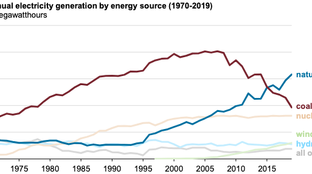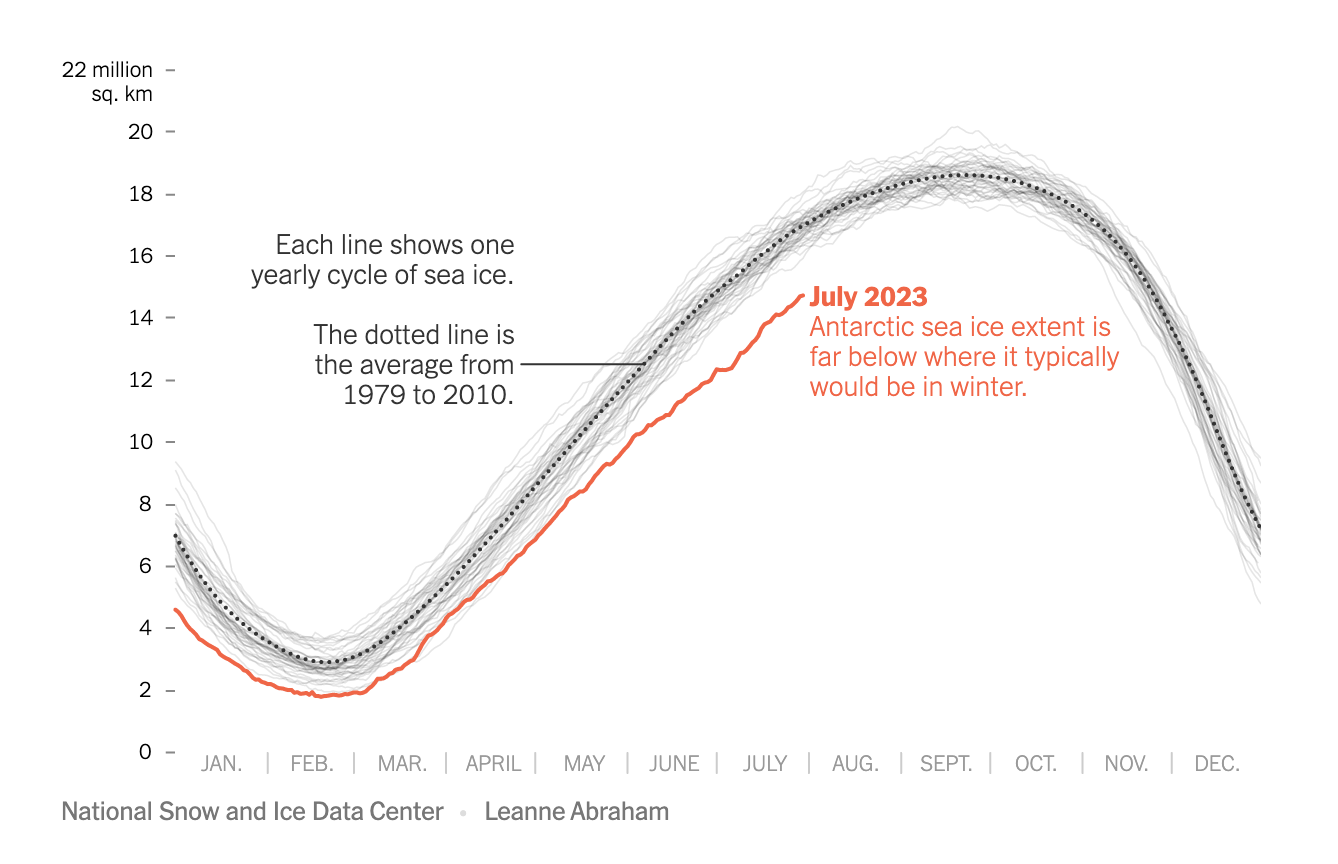
🌎 Coal hard facts #241
Trump’s coal push ignores economic reality and attractive alternatives
Long-awaited new nuclear power capacity at Plant Vogtle comes online
Happy Monday!
The US grid got its first new nuclear power in nearly seven years last week. Plant Vogtle began commercial operations from the first of two new reactors, but the over-budget and years-delayed project could be the last hurrah for big nuclear construction in America.
Meanwhile, the ice in Antarctica is way behind its typical seasonal growth this year. The UK is set to approve more than 100 new oil and gas licenses, and the Biden Administration flips the final switch on incandescent light bulbs.
In deals this week, $125M for biomaterials made from CO2, $33M for grid power storage optimization, and $26M for carbon-sequestering cement.
Not a subscriber yet?
📩 Submit deals, announcements, events & opportunities, or general curiosities for the newsletter at [email protected].
💼 Find or share roles on our job board here.
A new nuclear reactor began sending power to the grid last week—the first to do so in the US in nearly seven years. It’s the first of two massive new reactors at Plant Vogtle in Georgia (the second is set to come online later this fall), which will become the largest nuclear power station in the US once all four reactors are fully operational.
The progress is being celebrated by nuclear boosters, but the long-delayed and over-budget project may actually mark the end of new conventional nuclear construction in the US, rather than a resurgence.
The details: The Plant Vogtle expansion project, which Southern Company subsidiary Georgia Power owns a majority stake in, has been under construction since 2009.
Nuclear power makes up nearly 20% of electricity generation in the US and around half of America's carbon-free electricity. Vogtle’s expanded operation will bring nuclear to ~4% of new power plant capacity this year, though it’s far outpaced by new solar (49%), wind (13%), and battery storage (16%).
Last year, 8 GW of new nuclear capacity came online globally, but the IEA estimates that reaching net zero could require more than 4x that rate of annual deployment by 2030.
The last new nuclear reactor to come online in the US was in October 2016, when the Tennessee Valley Authority began commercial operation of its Watts Bar Unit 2. Before that, Watts Bar 1 first delivering electricity to the grid in May 1996 was the most recent addition to American nuclear power.
The snail’s pace for new nuclear energy is due to a combination of factors, including public sentiment about its safety and role in the clean energy transition, as well as the large upfront capital costs and daunting regulatory process.
Plant Vogtle very well could be the “swan song” of the conventional nuclear industry in the US, as the extreme delays and cost overruns push the industry toward the advanced tech of small modular reactors (SMRs).
The new reactors at the Georgia site are the first deployment of the Westinghouse AP1000 models in America, even as China has four units already operating and another four underway.
Vogtle’s new reactors are also the first to have completed the full US Nuclear Regulatory Commission (NRC) licensing process—all others in operation began that journey before the NRC was created in 1975. While the NRC has issued permits for construction of eight more nuclear reactors at or near existing US plants, none are expected to reach operation.
Instead, the nuclear industry is betting on SMRs, a category of advanced nuclear fission reactors that have a power generation capacity between 50 MW and 500 MW per unit. This means even the largest SMR is about half the size of existing reactors. The thinking is that smaller projects create financing, siting, manufacturing, and safety benefits compared to traditional reactors.
But a smaller nuclear project is still a nuclear project. Despite SMR milestones earlier this year, next-generation nuclear will need to pass critical technical, financial, and regulatory checkpoints before it gets the green light to send carbon-free electricity to the grid.
🧪 Newlight Technologies, an Irvine, CA-based CO2 utilization platform using natural microorganisms to make biomaterials, raised $125M in Growth funding from GenZero, Oxy Low Carbon Ventures, and Charter Next Generation.
🔋 Equilibrium Energy, a San Francisco, CA-based grid power storage optimization services provider, raised $33M from Breakthrough, Global Founders Capital and NJP Ventures.
🧱 Carbon Upcycling Technologies, a Calgary, Canada-based company mineralizing CO2 into industrial byproducts, raised $26M in Series A funding from BDC Capital, Climate Investment, Strategic Investors, Oxy Low Carbon Ventures, CRH Ventures, Cemez Ventures, Clean Energy Ventures, and other investors.
🏭 Compact Membrane Systems, a Wilmington, DE-based developer of membranes for industrial carbon capture, raised $17M in Series A funding from Pangaea Ventures, GC Ventures, Solvay Ventures, Chevron Technology Ventures, and Technip Energies.
💨 Revalue Nature, a London, UK-based nature-based carbon project developer, raised $10M in Series A funding from Ecosystem Integrity Fund and SJF Ventures.
☀️GlassPoint, a Fremont, CA-based industrial solar steam developer, raised $8M in Series A funding from 300PPM.
🏠 SnoFox Sciences, a Philadelphia, PA-based cold chain data platform, raised $5M in Seed funding from Voyager Ventures, Mudcake, Pale Blue Dot, and Ponderosa Ventures.
☔ Divirod, a Boulder, CO-based real-time water risk monitoring platform, raised $4M in Seed funding from GHD, Thin Line Capital, and TDK Ventures.
⚡ OpConnect, a Tigard, OR-based EV charging infrastructure provider, raised $3M in Series A funding from The 22 Fund.
🌾 GroGuru, a San Diego, CA-based water management platform for farmers, raised $2M in Series A funding from Cove Fund, Impact Venture Capital, Integral Capital Partners, Comeback Capital, Right Side Capital Management, and other investors.
🚚 TruckLabs, a a Phoenix, AZ-based trucking decarbonization solutions provider, raised an undisclosed amount in Series B funding from Blue Bear Capital and Calibrate Ventures.
🏭 Hybar, an Osceola, AR-based scrap metal recycling developer, raised $700M from Global Principal Partners and TPG Rise Climate Fund.
🚚 WattEV, a Long Beach, CA-based Heavy-duty EV provider, raised $41M in Grant funding from The California Transport Commission and The Oregon Department of Environmental Quality.
⚡ Aemetis, a Cupertino, CA-based biofuel producer, raised $25M in Grant funding from The U.S. Department of Agriculture.
AB CarVal, a Minneapolis, MN-based investment firm part of investment management firm AllianceBernstein, raised $1.5B for their second clean energy fund focused on credit and hard-asset investments.
Prime Movers Lab, a Wyoming, WY-based investment firm, raised $245M for their third fund investing in deep tech companies.
Ocean 14 Capital, a London, UK-based investment firm, announced a further $33M in funding for their fund investing in ocean health.
Share new deals and announcements with us at [email protected]
The U.K. will grant over 100 new oil and gas licenses for the North Sea in a bid for energy security and jobs. Environmental groups and scientists protested the deal and Andrew Forrest, billionaire mining entrepreneur, threatened to pull investments from the country over its backing of fossil fuels.
The White House proposed a new rule to facilitate clean energy project permitting. The rule under the National Environmental Policy Act (NEPA) would execute permitting compromises reached by Congress, remove Trump-era changes, and require project reviews to assess environmental justice and climate change.
Anartica recorded a precipitous decline in sea ice growth this year signaling concerns regarding ocean and air temperatures, ocean circulation, and ecosystems.

U.S. TransWest Express Transmission project broke ground this week after 18 years. The 730-mile power line will carry electricity from a wind farm in Wyoming to states like California, Arizona, and Nevada.
Global cholera cases are increasing in large part due to climate change-intensified storms becoming more frequent and wetter.
Argentina, Chile, and Paraguay experienced an uncommon winter heat wave, raising unease about climate change's impact in South America.
The Biden administration finalized its phase out of incandescent light bulbs, an energy efficiency effort that first began back in 2007, and considered a new standard to increase the requirement of light bulbs to 120 lumens per watt from the current 45 lumens per watt requirement.
Climate dads unite!
In this week’s bad news Bloomberg stories… missed sustainability commitments and emission reduction goals.
From Eden to exodus: water crisis spurs mass exodus in Mesopotamian villages.
DOE's 2023 Critical Materials list reveals supply risks in the clean energy sector.

The big implications of US clean hydrogen rules.
Mapping a path to equity for historically hard-hit communities through a federal funding infusion.
Leading up to the 2024 election, political leanings set up an economy vs climate divide that could affect climate funding.
SPF 1,000? Unintentional geoengineering and a novel approach to planetary shading—straight out of the Simpsons.
🗓️ Leading Transportation Agencies through Climate Mitigation and Adaptation: Join WTS at this educational session on Aug 9 to learn how the San Francisco Municipal Transportation Agency and BART make bold changes to their transportation infrastructure to achieve their climate roadmap goals.
🗓 SF Blue Tech Happy Hour Meetup: Attend SF Blue Tech on Aug 9 to meet like-minded scientists, ocean experts, tech professionals, students, and investors to network and share ideas about blue tech start ups, ocean restoration efforts, ocean farming, and more.
🗓 Investing in Innovation: Join CEBN and the Environmental Defense Fund on Aug 15 for a webinar to discuss new and existing programs for energy innovators with a high-level overview of federal resources for climate tech startups, entrepreneurs, incubators, and investors.
🗓 MCJ Climate Tech Meetup Boston - Summer 2023: Meet Boston MCJ (My Climate Journey) and the Boston climate tech community to collaborate with climate professionals and investors on Aug 17.
💡 Manifest Climate Grants: Apply by Aug 31 to this new fast grants program for the opportunity to win $25K-$100K, designed for scientists to test and accelerate ambitious and innovative climate bio tech ideas.
Innovation Associate @Powerhouse Ventures
PM, Decarbonization Data and Strategy – Renewable Energy Team @Microsoft
VP of Engineering, VP of Research @ Remora
Energy Markets Analyst, Chief Financial Officer @NineDot Energy
Demand Generation Manager @Terraformation
Strategic Account Executive, Product Manager @Overstory
Sales Lead @Infyos
Founding Software Engineer, Founding Operations Lead @Pioneer
Mechanical Engineer @Yard Stick PBC
Investor (Flagship Fund), Associate VP, Transmission & Distribution, Associate VP, Cyber & Digital Transformation @Energy Impact Partners
Senior Risk Officer, Financial Institutions, Senior Officer in Asset Management Renewables, Project Development Manager Renewables (f/m/d) @ Finance in Motion
Feel free to 📩 send us new ideas, recent fundings, events & opportunities, or general curiosities. Have a great week ahead!

Trump’s coal push ignores economic reality and attractive alternatives

The tariffs' toll, explained sector-by-sector

The AI company’s debut shows where the chips are falling